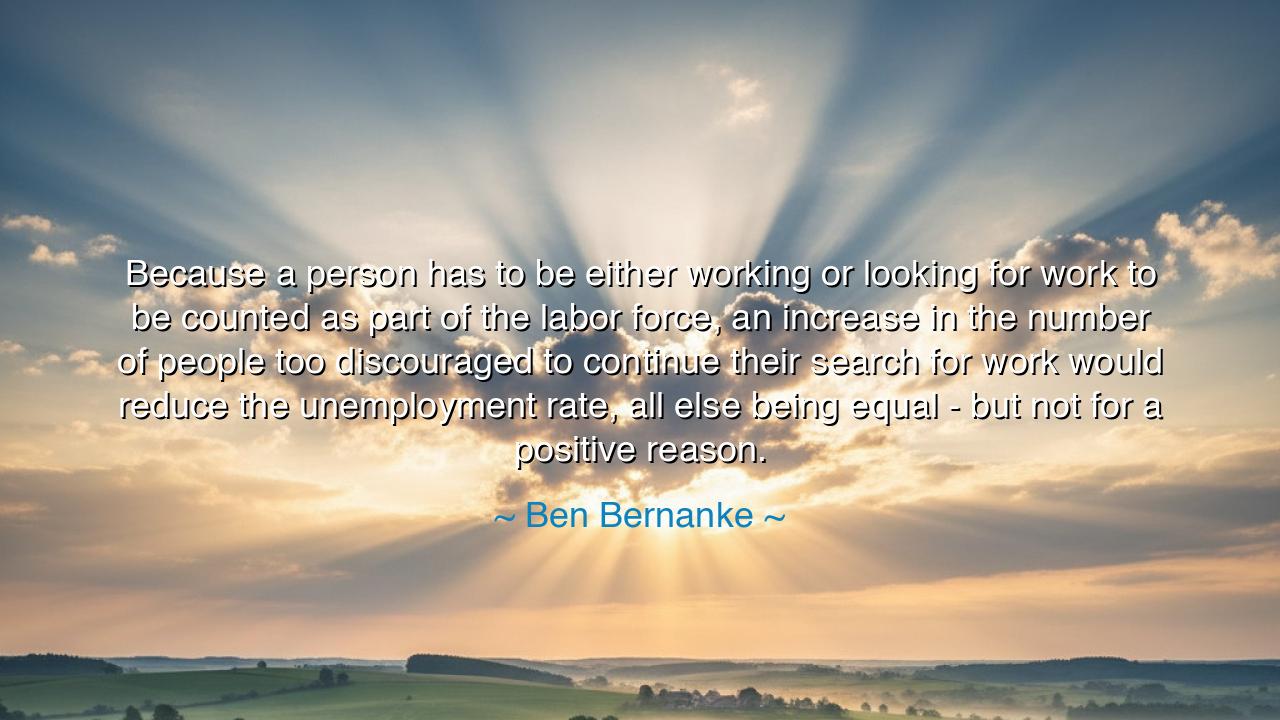
Because a person has to be either working or looking for work to
Because a person has to be either working or looking for work to be counted as part of the labor force, an increase in the number of people too discouraged to continue their search for work would reduce the unemployment rate, all else being equal - but not for a positive reason.






The words of Ben Bernanke, “Because a person has to be either working or looking for work to be counted as part of the labor force, an increase in the number of people too discouraged to continue their search for work would reduce the unemployment rate, all else being equal—but not for a positive reason,” uncover a sobering truth: numbers alone do not tell the whole story of human struggle. A falling unemployment rate may look like prosperity, but if it hides despair, if it hides those who have abandoned hope, then the statistic becomes a mask, not a mirror.
The origin of this wisdom lies in the ancient conflict between appearances and reality. Leaders have long pointed to measures of strength—grain tallies, coin counts, soldier numbers—as proof of stability. Yet behind these figures were often lives worn thin by hardship. Bernanke reminds us that in the realm of work, as in life, truth cannot be measured only by what is seen; the unseen—those who have grown too weary to seek—must also be counted in our conscience.
Consider the story of the Great Depression of the 1930s. Official unemployment rates captured the millions who searched desperately for jobs, but they could not fully measure the despair of those who had ceased searching altogether, broken by endless rejection. Men roamed the countryside, families huddled in makeshift camps, and yet their absence from official counts gave the illusion that the crisis was not as deep as it truly was. This is exactly the caution Bernanke gives: that statistics without compassion risk distorting reality.
His words also reveal the danger of mistaking positive appearances for genuine health. A society that takes comfort in falling unemployment while ignoring the discouraged has chosen illusion over truth. For what good is a number if it conceals suffering? What good is a system if it abandons those who lose hope? True prosperity is not when the rates decline, but when human dignity rises—when people are not only counted but cared for.
The lesson is sharp and enduring: beware of measures that flatter, for they may blind you to the cries of the people. A positive statistic born of despair is not progress, but warning. Leaders and citizens alike must learn to look beyond numbers, to hear the silence of those who no longer speak, to see those whom charts forget.
Let the generations remember: the true health of a nation is not in its unemployment rate, but in the spirit of its people. To leave even the discouraged behind is to build prosperity upon sand. Only when every worker has both opportunity and hope can numbers and reality walk hand in hand, and the labor force become not a measure of despair, but of strength.






GDGold D.dragon
Ben Bernanke’s quote highlights a key issue in how we define unemployment. While a decline in the unemployment rate might seem like a positive sign, it doesn’t capture the real economic distress of people who are no longer actively looking for work. How do we address the issue of discouraged workers and give a more accurate reflection of labor market conditions? Is it time to reconsider how we measure joblessness in today’s economy?
BBaren
I find Bernanke’s observation about discouraged workers interesting, especially since it exposes a gap in how we view unemployment. Shouldn't we be looking at other indicators, like the number of people who are underemployed or those who’ve dropped out of the labor force, to get a clearer picture of economic health? The unemployment rate doesn’t always reflect the struggles of people who are still unemployed but no longer counted as such.
NMQuang Nguyen Minh
Ben Bernanke raises an important point about how the unemployment rate can be misleading. People who are no longer actively searching for work are no longer counted as unemployed, even though they are still struggling. How can we reform the way we calculate and report unemployment to account for those who are discouraged and not actively seeking work, but still need jobs? Could there be a better metric for understanding real economic hardship?
TPToan Pham
Bernanke’s comment highlights a flaw in the way unemployment is measured, and it’s a reminder that not all economic indicators tell the whole story. If a significant number of people stop looking for work, the unemployment rate might improve, but that’s not necessarily a positive trend. What are some alternative ways we could measure unemployment that would provide a more accurate picture of the labor market and the struggles people face?
TDDo Tien Dat
This quote from Bernanke makes me think about how economic metrics can sometimes mask the true state of the job market. While an increasing unemployment rate may be a clear sign of economic trouble, a decreasing rate could sometimes hide the fact that people are giving up on finding jobs. How do we ensure that we’re capturing the full scope of the labor market situation, especially when people are discouraged and no longer counted?